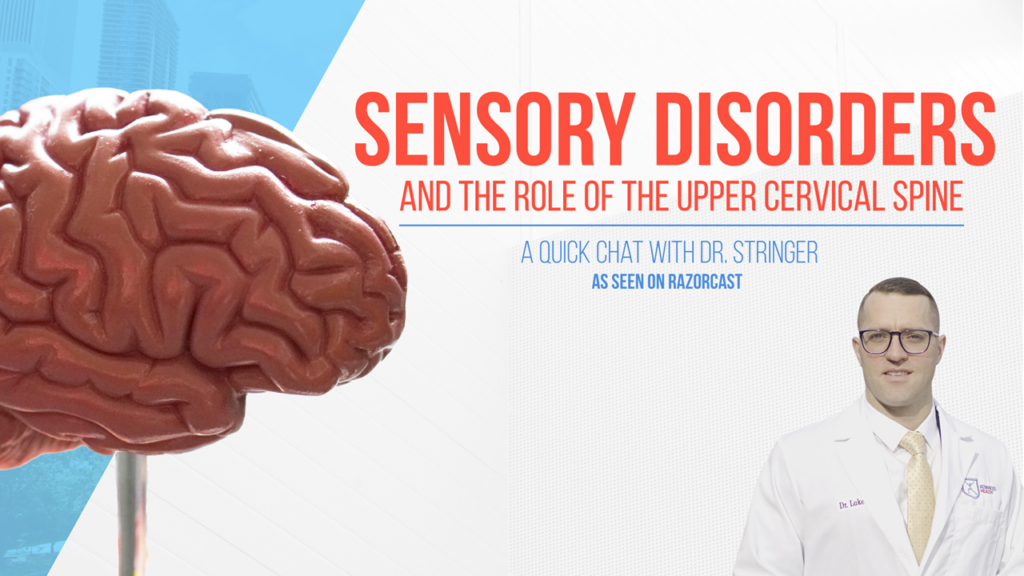
Autism, ADD, ADHD, and other sensory disorders all fall within a realm of developmental disability, which is caused by a difference in the brain, which results in sensory issues such as sensitivities to light and sound, inability to concentrate and focus, behavioral issues, difficulty with social cues and more.
A chiropractor’s specialty is the spine. The spine houses the nervous system, the nervous system controls everything we do, how the body feels, also how it functions. When we have kids in the practice with different varying degrees of these sensory disorders, we’re always looking at what we call the three Ts, Thoughts, Toxins, Traumas.
For kids, thoughts can be stress that’s coming from school. So, we’ll discuss with the parent good ways that they can manage stressful situations because that has an effect on the nervous system, which has an effect on how the patient feels and functions.
Toxins can come from diet. Diets that are high in inflammatory foods, processed foods, color additives, et cetera really tax the body and have a harsh effect on the nervous system, creating free radicals that pull oxygen out of cells and just essentially doesn’t allow us to function well.
The last T is for trauma and children typically suffer from micro traumas or micro stresses. The child is playing on a tablet, the chin is on their chest, they’re looking down. That’s a micro stress. Micro stresses create something called subluxation. There are several forms of subluxation, but essentially it means a joint or several joints of the spine globally can shift out of alignment. If the spine shifts, it can increase stress and tension in the joint, the tissue, and the nerves.
When a child has varying degrees of ADD, ADHD, or Autism, and they come to us for help, we always check the spine, specifically the upper cervical spine, for subluxations. And more often than not, we are finding subluxations present due to lack of curve, reverse curve and or joint shifts in that upper cervical spine.
You have seven bones in your neck. The first two are the upper cervical spine, C1, C2, cervical bones, the top bone is called the atlas and the axis. And the skull sits on top of the atlas and then the atlas sits on top of the axis and essentially that’s how we rotate our head. Then look up and down a little bit too. When these joints have shifted out of alignment, they can create stress and tension on the C1, C2 nerve route. From your brain, you follow your brain stem and then out of your skull through the foramen magnum which is the hole in the base of the skull, comes the spinal cord. If you are subluxated in that region, you’re going to increase stress and tension in the upper cervical area. There’s more nervous system activity in that area than anywhere else in your spine because you’re so close to the brain stem.
For kids we’re always checking that upper cervical spine to see if it was subluxated and if it was compressing the C1, C2 nerve route right by that brain stem. That can put us in something what we call sympathetic tone. If children are in a sympathetic tone, typically what we find is that they are just struggling with autism, ADD, ADHD, all those types of sensory disorders.
We focus on the upper cervical spine with our sensory patients. If we can get that spine moving better, in better alignment, with better balance, healthy muscle tone and strength, it is going to allow those two joints to move freely without compressing the nervous system. Then typically what we see is a decrease in those symptoms. Each patient’s symptoms are different based on their case but for any kid that’s dealing with kind those sensory disorders, by getting in to see a chiropractor, they are going to see some awesome, wonderful stuff happen through the chiropractic adjustment.
Once we start working with patients on good joint function and good alignment to decrease the stress and tension on the nervous system, their sensory issues start to improve pretty quickly and pretty drastically. We’ve got some awesome case studies in the office in regard to patients responding to care from kids picking back up their musical instrument that they gave up, from pulling their grade average way up from failing to being an honor roll student, to having the ability to sit in the canteen at school and actually socially interact with the friends due to their ability to absorb noise better. It’s a wonderful thing when you’re working with kids and they receive chiropractic treatment and the benefits that it comes with.
